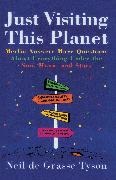Share
Neil de Grasse Tyson, Neil Degrasse Tyson
Just Visiting This PLanet
English · Paperback / Softback
Description
Zusatztext "Tyson has created a space-age Merlin. An astrophysicist and educator! Tyson weaves together imaginative with straightforward science." --USA Today Informationen zum Autor Neil deGrasse Tyson is an astrophysicist with the American Museum of Natural History! director of its world-famous Hayden Planetarium! host of the hit radio and TV show StarTalk ! and an award-winning author. He lives in New York City. Merlin is as old as Earth and has been an eyewitness to nearly all major human discoveries in the physical sciences. On temporary leave from home--the planet Omniscia in the Draziw star system of the Andromeda galaxy--Merlin has chosen Earth and its scientific legacy as a topic of academic research. Merlin has advanced degrees in astrophysics, geophysics, chemistry, and philosophy, all earned at Omniscia's planetwide Universe-ity. A consummate scholar-educator, Merlin loves nothing more than to answer your questions about our favorite universe. Steadfastly succinct yet always friendly, Merlin's replies are occasionally enriched by recollections from the past--a past that contains a motley assortment of Merlin's Earth-based friends and acquaintances, including Archimedes, Galileo, Einstein, and Santa. Dear Merlin, With all the motion of Earth through space, when I jump, how come I don't land in a different place? JOSHUA WALTON DUVALL, WASHINGTON You do land in a different place in space, but the ground stays with you. If you jump straight up and manage to stay airborne for one second, then you will land over 500 yards east (the rotation of Earth carried you there) and 18 miles farther around the Sun (the orbit of Earth carried you there) and about 125 miles farther around the center of the Milky Way galaxy (the orbit of the solar system took you there). Incidentally, all this happens in one second even if you do not jump. Dear Merlin, What is a blue moon? LINDA HAYDEN, MOONMAIDEN ARCADIA, SOUTH CAROLINA In the absence of blue-tinted moon glasses or peculiar atmospheric optics, a blue moon is simply the second full moon in a calendar month. With months of twenty-eight, twenty-nine, thirty, and thirty-one days and the average cycle of full moons requiring twenty-nine and a half days, the average time between blue moons is about two and a half years. Occasionally, however, blue moon enthusiasts get a treat. In 1999, 2018, and again in 2037, January has two full moons. In each year, February follows with no full moon, but then March dons two full moons of its own. Dear Merlin, Our planet is becoming overburdened with atomic waste and hazardous materials at an alarming rate. Why can't we put some of it on space flights when room is available and have the astronauts nudge the stuff in the direction of the Sun? LESTER DUBACH HELLMAN PRESCOTT VALLEY, ARIZONA What you call a "nudge" from an already orbiting space station amounts to shoving the atomic waste in the right direction at a speed of about 7,000 miles per hour. Only then will it escape the gravitational pull of Earth. If the high-speed nudge fails, the waste will reenter Earth's atmosphere and create an even greater health risk. The solution for your planet is to find sources of energy that do not produce atomic and otherwise hazardous wastes. Dear Merlin, At about 10:30 p.m. this past July 31, my mom and I saw a small reddish light move quickly across the sky. It tracked through the Big Dipper. It did not blink, like a plane's light might. It was gone from our sight after fifteen seconds or so. Do you think it was a satellite? If so, what kind? And where are they going? How can we see more of them? CARA AND KERRY DUBYK FURLONG, PENNSYLVANIA Since your mother also saw the light, Merlin presumes you were not hallucinating. You p...
Product details
| Authors | Neil de Grasse Tyson, Neil Degrasse Tyson |
| Publisher | Main Street Books |
| Languages | English |
| Product format | Paperback / Softback |
| Released | 13.07.1998 |
| EAN | 9780385488372 |
| ISBN | 978-0-385-48837-2 |
| No. of pages | 352 |
| Dimensions | 142 mm x 217 mm x 18 mm |
| Subject |
Natural sciences, medicine, IT, technology
> Physics, astronomy
> Astronomy
|
Customer reviews
No reviews have been written for this item yet. Write the first review and be helpful to other users when they decide on a purchase.
Write a review
Thumbs up or thumbs down? Write your own review.

